12 best ways to free up hard drive space on Windows 10
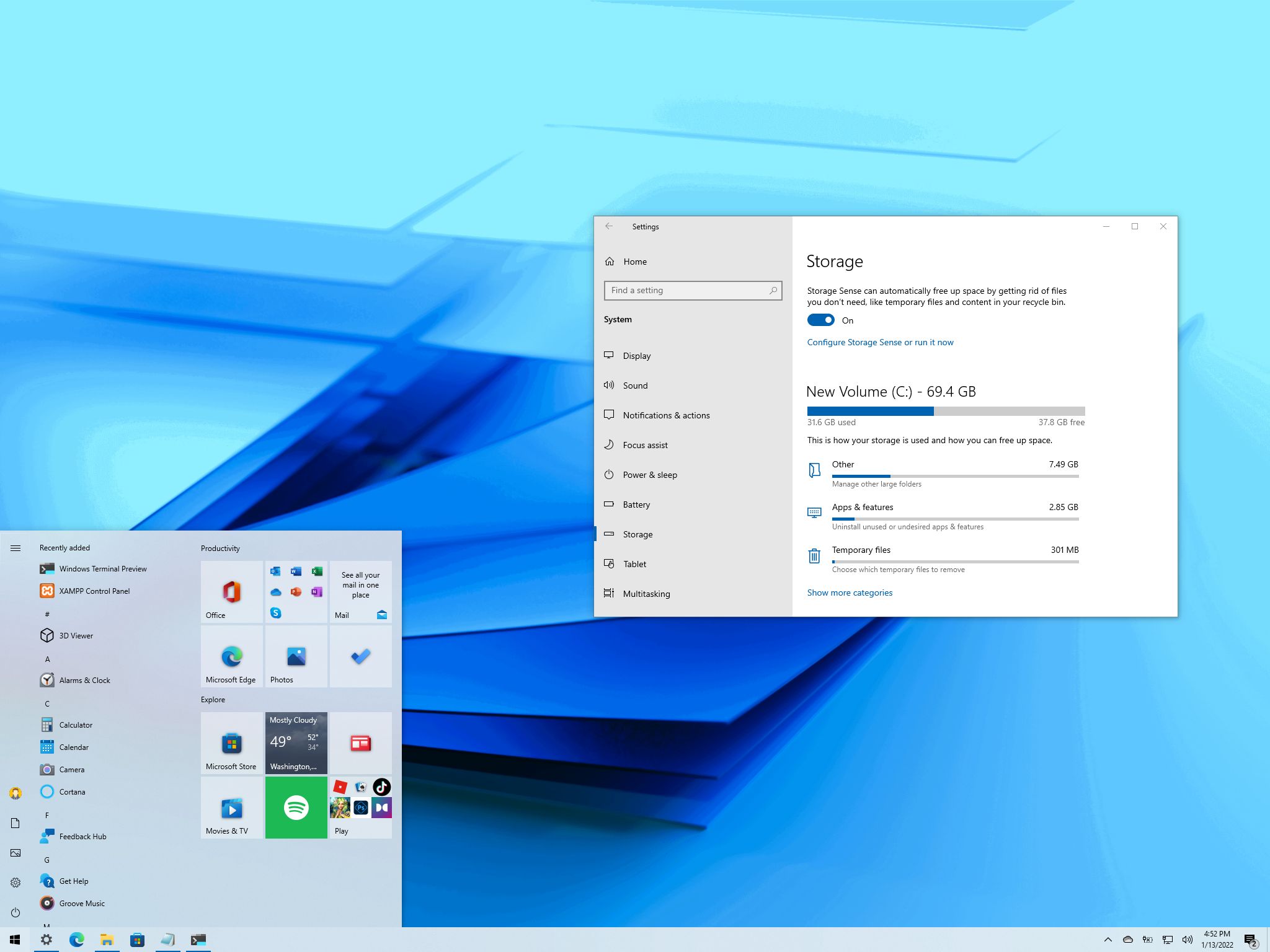 Source: Windows Cardinal
Source: Windows Cardinal
On Windows 10, y'all take several options to free up space on your computer. Although nowadays, laptops and desktops come with drives featuring multiple terabytes of storage, we always find a way to fill them upward with documents, pictures, videos, apps, and games, causing the system to work slower, issues saving files, and many other issues.
If your device is running low on space, Windows x comes with tools like Storage Sense, OneDrive Files On-Demand, Meaty Os, NTFS compression, and others to delete unnecessary files, apps, and games, which can help to reclaim space, improve performance, and resolve problems during updates.
In this Windows 10 guide, nosotros will walk you through the best means to free up storage infinite on your computer to store more files and install feature updates without issues.
- Costless up infinite clearing Recycle Bin on Windows ten
- Free up space removing junk files with Storage Sense on Windows ten
- Gratis up space deleting temporary files using Disk Cleanup on Windows 10
- Free upward infinite using OneDrive files on-demand on Windows 10
- Complimentary up infinite removing non-essential apps and games on Windows ten
- Free up infinite trasnfering files to external drive
- Gratis up space using NTFS compression
- Free up space disabling Hibernation on Windows 10
- Free up space compressing installation footprint of Windows x
- Free up space rebuilding search indexer on Windows ten
- Free up space deleting users no longer sharing device on Windows 10
- Complimentary upwardly space disabling Reserved Storage on Windows x
one. Free up space clearing Recycle Bin on Windows ten
Windows 10 doesn't erase the files from the hard drive when you lot delete them. Instead, they are relocated to the Recycle Bin and marked for deletion to give you lot the risk to recover the files if you need them back. However, since the Recycle Bin tin grow large over time, elimination its contents is the first thing you can do to costless up space.
On Windows 10, when deleting files, the system does not erase them from the difficult drive. Instead, they are placed within the Recycle Bin if you need them back. Nonetheless, depending on how the characteristic is configured, over time, the Recycle Bin can take up a lot of space, which ways that emptying the bin is one of the first actions you should take to regain valuable storage infinite.
To empty the Recycle Bin to regain storage space on Windows 10, utilise these steps:
- Open Start.
-
Search for Recycle Bin and click the top event to open the app.
Quick tip: If the app does not announced in the result, you lot can open File Explorer (Windows key + E) and so type Recycle Bin and press Enter in the address bar.
- Click the Recycle Bin Tools tab.
-
Click the Empty Recycle Bin push.
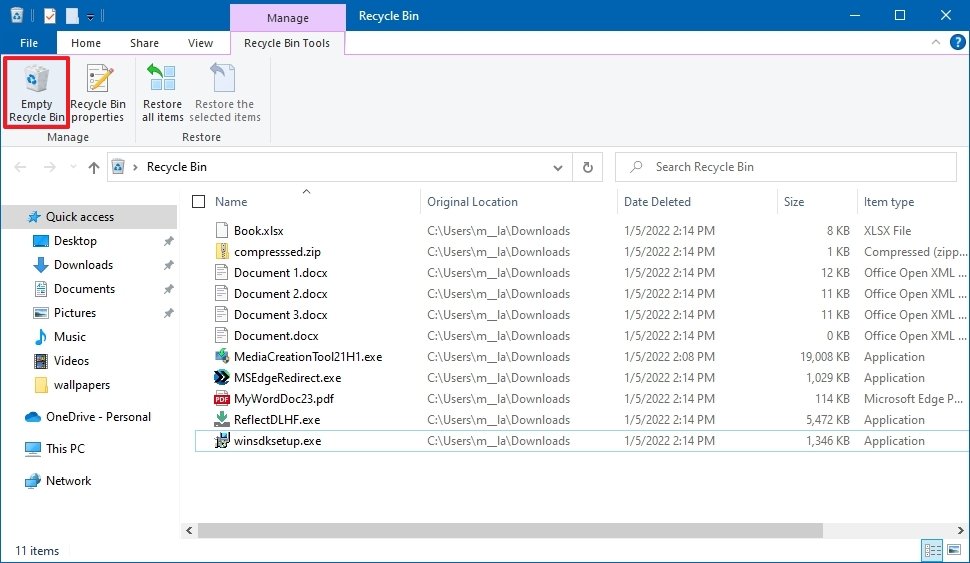 Source: Windows Central
Source: Windows Central - Click the Yes button.
Once y'all complete the steps, the organisation will gratuitous up around x per centum of the bulldoze capacity (bold the Recycle Bin is full).
Alter Recycle Bin settings
Windows 10 reserves 10 per centum of the available infinite for deleted files. One time the threshold is reached, the system will automatically delete files from the oldest to the newest. If you lot desire, it's possible to adjust how much space the system should use for the Recycle Bin.
To reduce the space usage for the Recycle Bin, utilise these steps:
- Employ the Windows + D keyboard shortcut to view the desktop.
-
Correct-click the Recycle Bin icon and select the Properties option.
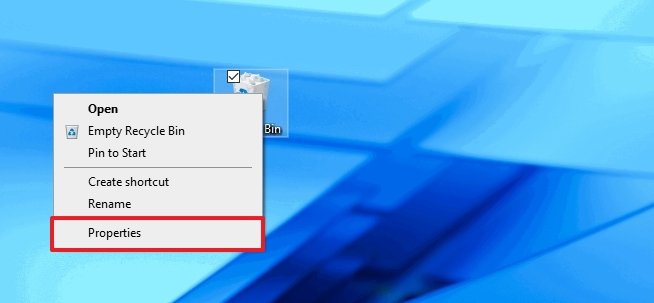 Source: Windows Central
Source: Windows Central - If you lot take multiple partitions, select the Recycle Bin location you want to configure. For example, Local Disk (C:) is the bulldoze where Windows x is installed.
- Nether the "Settings for selected location" section, select the Custom size option.
-
In the "Maximum size (MB)" field, specify the maximum hard drive space in megabytes that Recycle Bin can utilize on the particular sectionalisation.
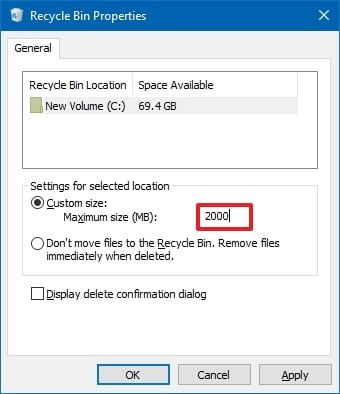 Source: Windows Central
Source: Windows Central - (Optional) Bank check the Don't move files to the Recycle Bin. Remove files immediately when deleted option if you lot desire to delete the files from the drive skipping the Recycle Bin to minimize storage usage.
- Click the Apply button.
- Click the OK Button.
After you complete the steps, the Recycle Bin volition be able to keep more than or fewer files from a particular location, depending on your configuration.
ii. Costless up space removing junk files with Storage Sense on Windows 10
Storage Sense is a feature that allows you to delete unlike types of junk files (including previous installation files after an upgrade and temporary files) to free upwards space on the master and secondary drives to make room to store other files and ameliorate drive efficiency.
Enable Storage Sense
Although you tin use Storage Sense manually, it'southward possible to enable the characteristic to run maintenance automatically to assistance avert running out of space quickly.
To enable Storage Sense on Windows ten, apply these steps:
- Open Settings.
- Click on Arrangement.
- Click on Storage.
-
Under the "Storage" section, click the Configure Storage Sense or run information technology now option.
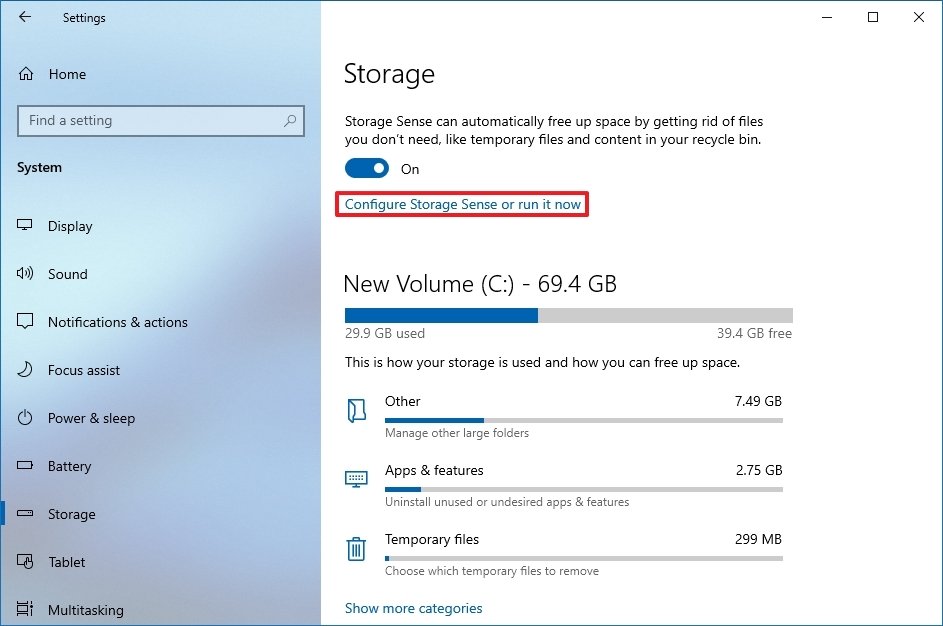 Source: Windows Cardinal
Source: Windows Cardinal - Plow on the Storage Sense toggle switch.
-
Utilise the "Run Storage Sense" drop-downwardly card and select the best choice for your situation:
- Every day.
- Every week.
- Every calendar month.
- During depression free disk infinite (recommended).
 Source: Windows Fundamental
Source: Windows Fundamental
One time y'all consummate the steps, Storage Sense will run automatically at the schedule you specified to free up space and improve storage operation.
The option to enable the feature is as well available from the "Storage" page. Still, using this option only activates the default settings. Utilizing the Storage Sense settings folio lets you configure how the characteristic should remove unnecessary content.
Delete unnecessary files with Storage Sense
To free upwardly space using Storage Sense, use these steps:
- Open Settings.
- Click on System.
- Click on Storage.
-
Under the "Storage" section, click the Configure Storage Sense or run it now option.
 Source: Windows Central
Source: Windows Central - Under the "Temporary Files" department, check the Delete temporary files that my apps aren't using option.
- Apply the Recycle Bin drop-down menu to specify how to articulate already deleted files you practise not need.
-
Use the Downloads drop-down menu to specify how to clean up downloaded files.
Quick tip: If you demand to delete the most files, employ the 1 24-hour interval option. The Downloads folder may contain valuable files y'all may have downloaded from the internet, which ways that it is recommended to backup those files manually before running the feature.
-
Under the "Locally bachelor cloud content" section, employ the driblet-downwardly menu to specify how long OneDrive content synced to the device becomes online-only.
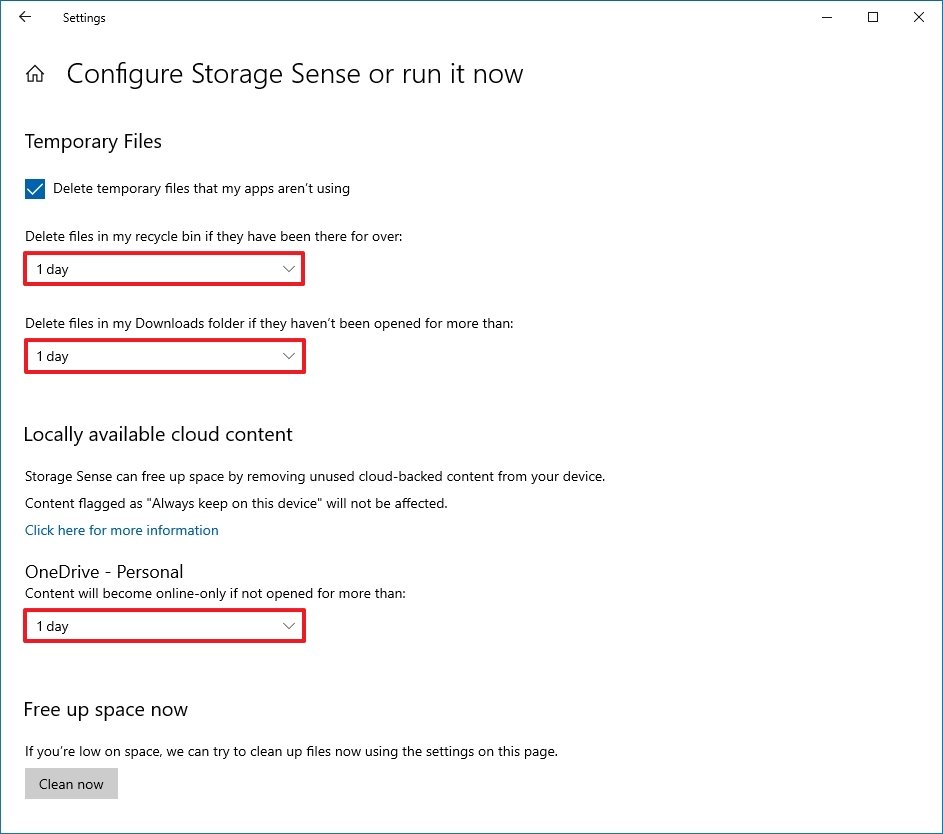 Source: Windows Fundamental
Source: Windows Fundamental Quick note: This selection is function of OneDrive Files On-Need that allows you to access your documents, pictures, videos, and other files using File Explorer without needing to sync them to reduce the space usage. When the device is running depression on space, you can apply information technology to brand files just available in the deject. You will still run into your files, just their content will only download when you lot need them.
-
Under the "Free upwards space now" section, check the Delete previous versions of Windows option (if applicable).
Quick note: This option can gratuitous up close to 20GB of space, but the storage volition vary from system to arrangement.
- Click the Clean now push button.
Storage Sense volition run and delete unnecessary files from the computer to reclaim more space after completing the steps.
Delete temporary files with Storage Sense
Storage Sense also deletes temporary system and apps files that can help to repossess several gigabytes of space on your Windows ten device.
To delete temporary files from the device, use these steps:
- Open Settings.
- Click on System.
- Click on Storage.
-
Nether the "Local Disk (C:)" section, click the Temporary files item. (If the item is not available, click the Show more categories choice.)
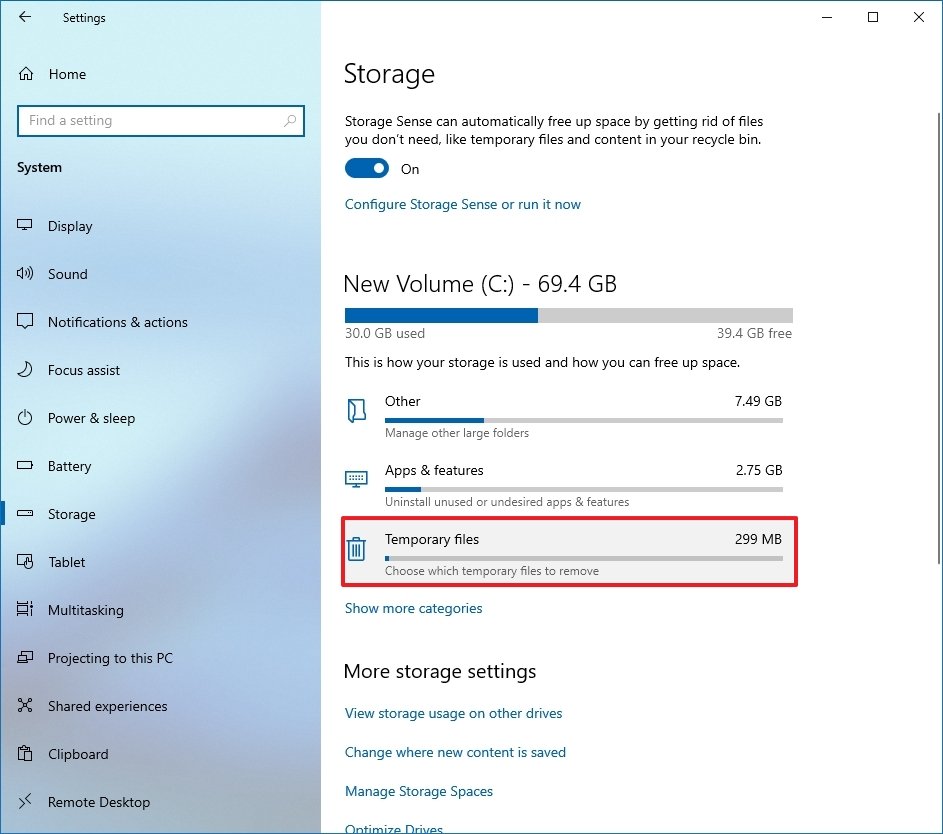 Source: Windows Central
Source: Windows Central -
Bank check all the items you desire to remove to optimize the space. For example:
- Downloads.
- Windows Update Cleanup.
- Recycle Bin.
- Delivery Optimization Files.
- Thumbnails.
- Microsoft Defender Antivirus.
- Temporary Internet Files.
- Temporary files.
- Windows error reports and feedback diagnostics.
- DirectX Shader Cache.
- Previous Windows installation(s).
- Temporary Windows installation files.
Quick tip: The available items may differ on your installation. If you lot want to select the Downloads item, before clearing these files, make certain to understand that this option will erase everything in that folder.
-
Click the Remove files push button.
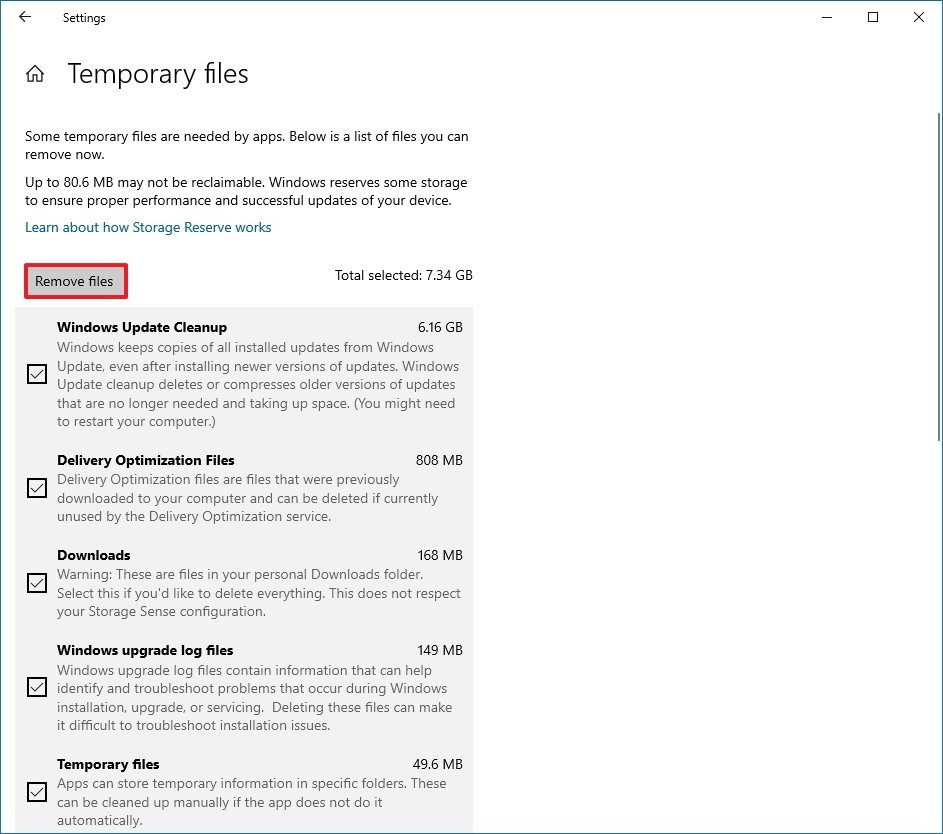 Source: Windows Key
Source: Windows Key
Afterward you complete the steps, the selected files will be deleted permanently, freeing up space for more important files.
View storage usage on Windows 10
On Windows 11, Storage Sense is likewise a neat tool to help y'all understand which files employ the well-nigh space to determine the files you can clean up.
To view the storage usage on Windows 10, use these steps:
- Open Settings.
- Click on System.
- Click on Storage.
-
Under the "Local Disk C:" section, click the Evidence more categories choice.
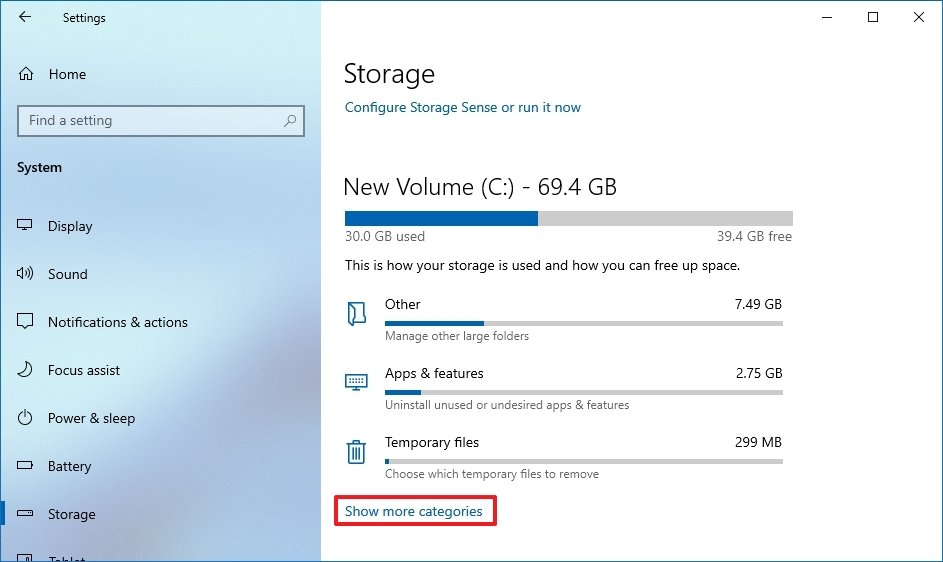 Source: Windows Fundamental
Source: Windows Fundamental -
See how the storage is being utilized.
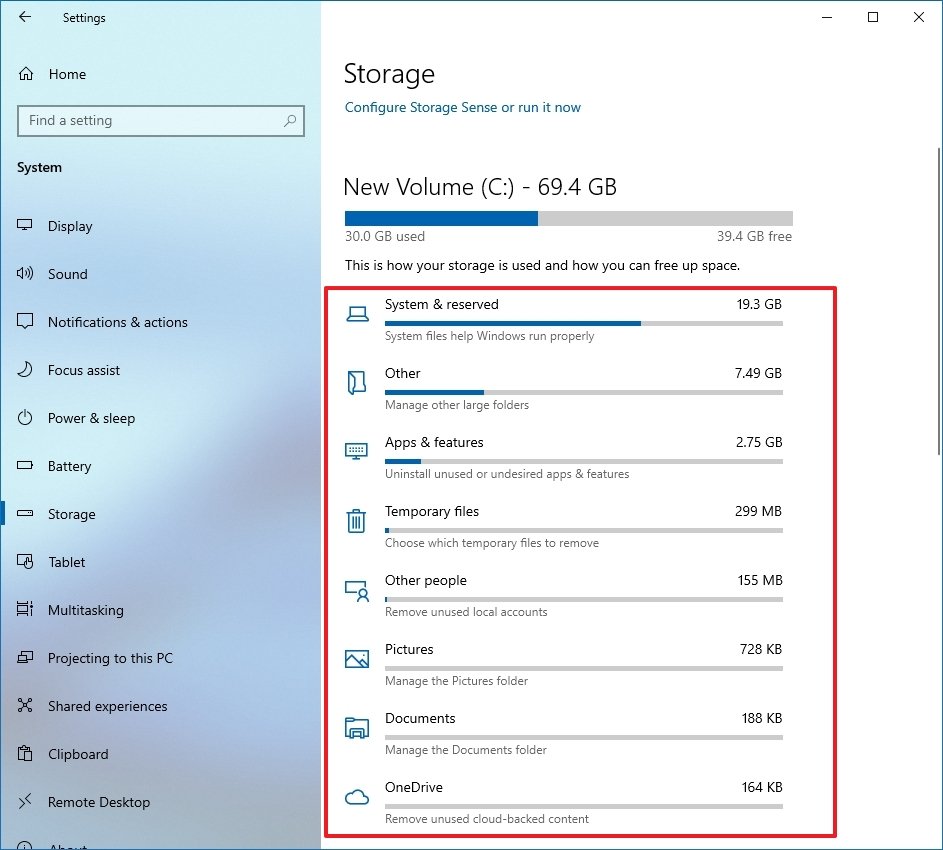 Source: Windows Fundamental
Source: Windows Fundamental - Select each category to run across even more than details and actions y'all can take to gratis up space on Windows 10.
Once you consummate the steps, you will find out the storage usage and focus areas to free up infinite. For example, inside the System & reserved category, yous will meet how much space the installation, virtual memory, hibernation files, and system restore are using, and the amount of infinite the system is reserving for updates.
If you lot have multiple drives, under the "More storage settings" department, click the View storage usage on other drives option to open the page that lists all the drives on the device.
3. Free up space deleting temporary files using Deejay Cleanup on Windows 10
On Windows ten, it's still possible to clear up space using the legacy Disk Cleanup tool.
Remove temporary files with Disk Cleanup
To apply Deejay Cleanup to delete temporary files on Windows 10, employ these steps:
- Open Start.
- Search for Disk Cleanup and select the acme result to open up the app.
- Use the "Drives" drop-down menu and select the (C:) drive (if applicable).
- Click the OK button.
-
Click the Cleanup arrangement files button.
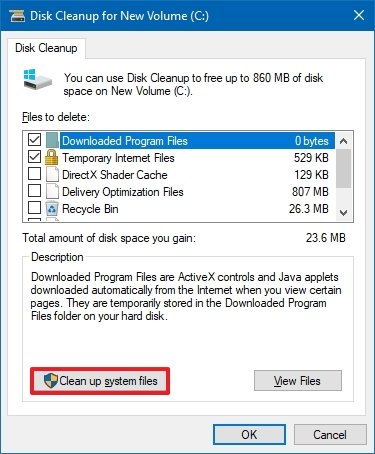 Source: Windows Central
Source: Windows Central - Use the "Drives" drop-downwards carte and select the (C:) drive.
- Click the OK button.
-
Check all the contents you desire to delete:
- Windows Update Cleanup.
- Microsoft Defender Antivirus.
- Downloaded Program Files.
- Temporary Cyberspace Files.
- Windows error reports and feedback diagnostics.
- DirectX Shader Cache.
- Delivery Optimization Files.
- Device commuter packages.
- Language Resource Files.
- Previous Windows installation(s).
- Recycle Bin.
- Temporary files.
- Thumbnails.
-
Click the OK button.
 Source: Windows Central
Source: Windows Central - Click the Delete Files button.
After y'all consummate the steps, those unnecessary files will be deleted from the device, freeing upwardly hard drive space.
Delete Organization Restore and Shadow Copies using Disk Cleanup
If you use Organization Restore and the Shadow Copies features, you can besides delete older files to reclaim additional infinite on Windows x.
To delete one-time organisation restore points, apply these steps:
- Open Beginning.
- Search for Disk Cleanup and select the top result to open the app.
- Use the "Drives" drop-downwards carte du jour and select the (C:) drive (if applicative).
- Click the OK push.
-
Click the Cleanup system files button.
 Source: Windows Central
Source: Windows Central - Click the More than Options tab.
-
Under the "System Restore and Shadow Copies" department, click the Clean upward push.
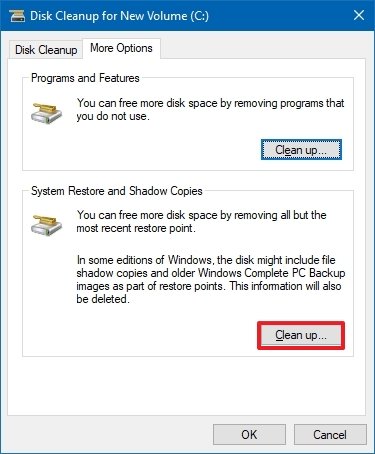 Source: Windows Central
Source: Windows Central - Click the Delete push button.
Later on you lot complete the steps, you will reclaim some additional infinite to store more important content.
four. Costless up space using OneDrive files on-demand on Windows 10
You can besides employ the OneDrive Files On-Need feature to make files available online only manually to regain some space back on your computer.
Enable OneDrive Files On-Demand
On Windows 10, the Files On-Need feature should be already enabled in OneDrive, merely if information technology is non, utilise these steps:
- Click the OneDrive icon in the lesser-right corner of the taskbar.
- Click the Help & Settings option.
-
Click the Settings choice.
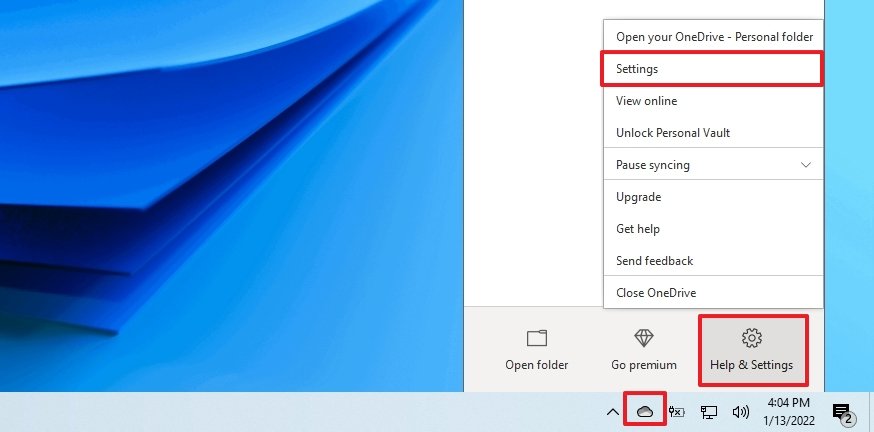 Source: Windows Central
Source: Windows Central - Click the Settings tab.
-
Under the "Files On-Demand" section, cheque the Relieve space and download files equally you use them option.
 Source: Windows Fundamental
Source: Windows Fundamental - Click the OK push.
One time you complete the steps, you can movement files to the OneDrive folder and make them available only online to free up space (see steps beneath).
Make files available online-only
To make local files available online-only with OneDrive, utilize these steps:
- Open File Explorer.
- Select the OneDrive folder from the left pane.
-
Select the files and folders taking up the most infinite.
Quick tip: You tin can select all files using the Ctrl + A keyboard shortcut by selecting the showtime file, holding down the Shift key, selecting the last files, or holding down the Ctrl key and selecting each file individually.
-
Right-click the option and choose the Free up space option.
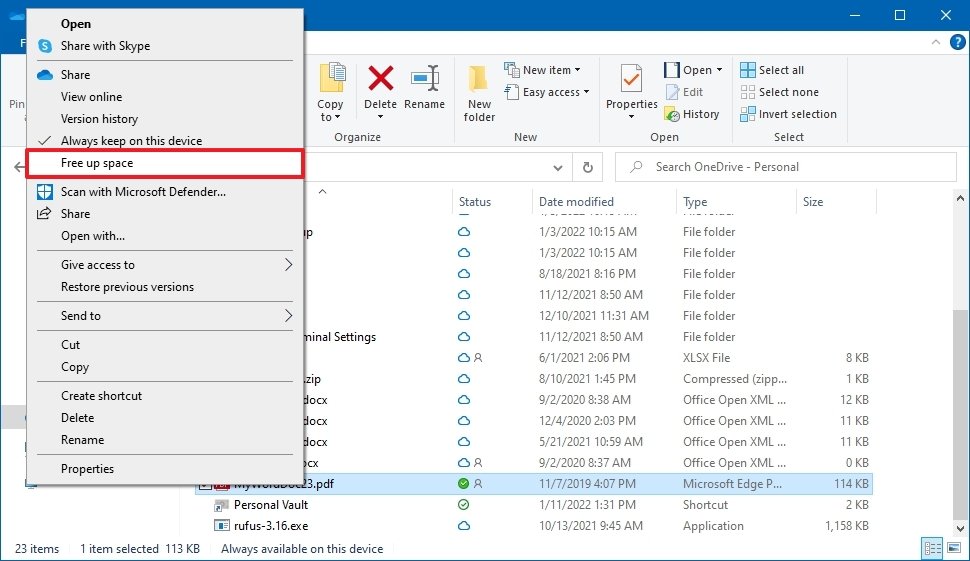 Source: Windows Central
Source: Windows Central
Afterwards you complete the steps, you volition be able to admission all of your content using File Explorer, but you will only be able to open them with an cyberspace connexion. In add-on to making synced files available but with an internet connection, y'all can costless up even more space by moving other files to the OneDrive folder and using the higher up steps to make them available on-demand.
The gratuitous version of OneDrive simply allows you lot to store upwards to 5GB of data. However, you lot can always get a Microsoft 365 subscription to lift the limit to 1TB. In add-on to the 1TB of storage, the subscription too gives you access to all the Function apps and services like Microsoft Teams and Family unit Safety.
Get subscribed

Microsoft 365
Microsoft 365 gives you full access to all the apps and perks, such as 1TB OneDrive storage and Skype minutes. You can besides install Word, Excel, PowerPoint, Outlook, and other apps on upwardly to five devices, and depending on the subscription, yous tin share the account with upward to six people.
5. Free upwardly space removing non-essential apps and games
Some other way you tin reclaim storage space is uninstalling apps you no longer need or rarely use. Games also take up a lot of space, which means that keeping the catalog to a minimum can significantly reduce space usage while improving gaming performance at the same fourth dimension.
To uninstall apps and games on Windows ten, use these steps:
- Open Settings.
- Click on Apps.
- Click on Apps & features.
- Use the "Sort by" filter and select the Size view to quickly identify the apps and games using the most space.
- Select the item to remove.
-
Click the Uninstall button.
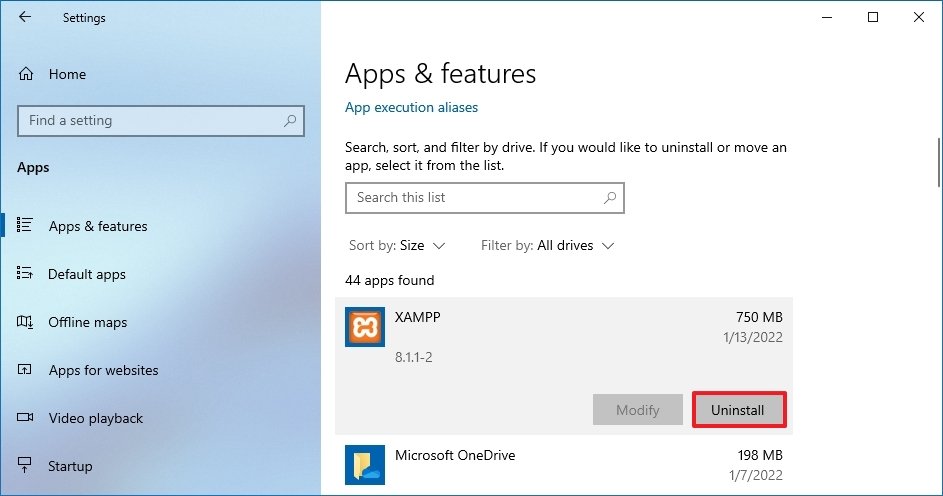 Source: Windows Central
Source: Windows Central - Click the Uninstall push once more.
- Continue with the on-screen directions (if applicable).
One time you complete the steps, echo the same instructions to remove additional apps and games from the figurer.
If you take previously enabled the Windows Subsystem for Linux, you may also have i or multiple distros still installed on your computer. You tin can always uninstall them to gratis upward space on Windows 10.
Delete unused languages
Secondary languages can also use some of the storage. If you are not using the other languages, remove them to make more room for additional files.
To uninstall languages on Windows 10, employ these steps:
- Open Settings.
- Click on Time & Language.
- Click on Language.
- Select the language to remove.
-
Click the Remove button.
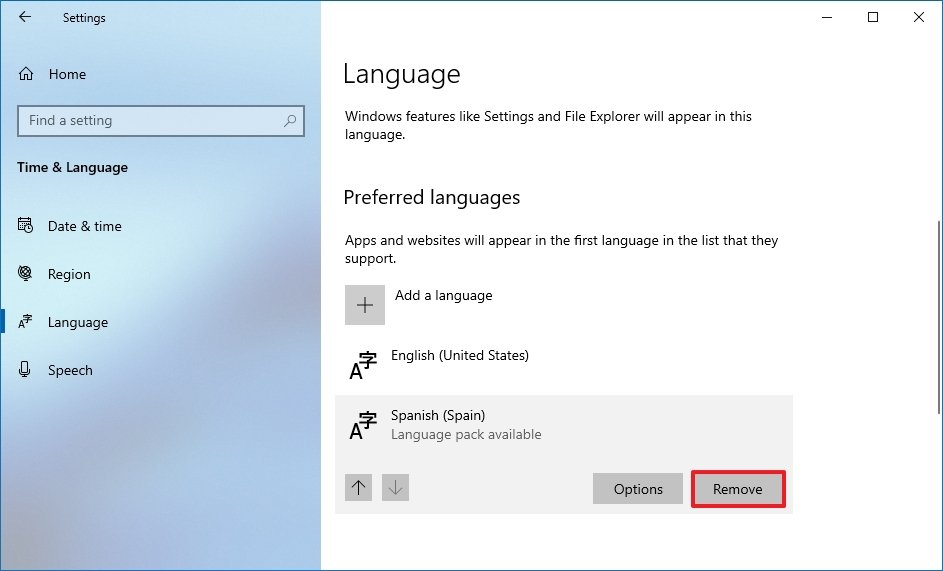 Source: Windows Central
Source: Windows Central
After you complete the steps, yous may need to echo the instructions to delete boosted languages as necessary.
Delete maps
If you use the Windows ten maps characteristic, you can remove the offline maps to clear upward some boosted space on the computer.
To remove downloaded maps packages, use these steps:
- Open Settings.
- Click on Apps.
- Click on Offline maps.
-
Click the Delete all maps push.
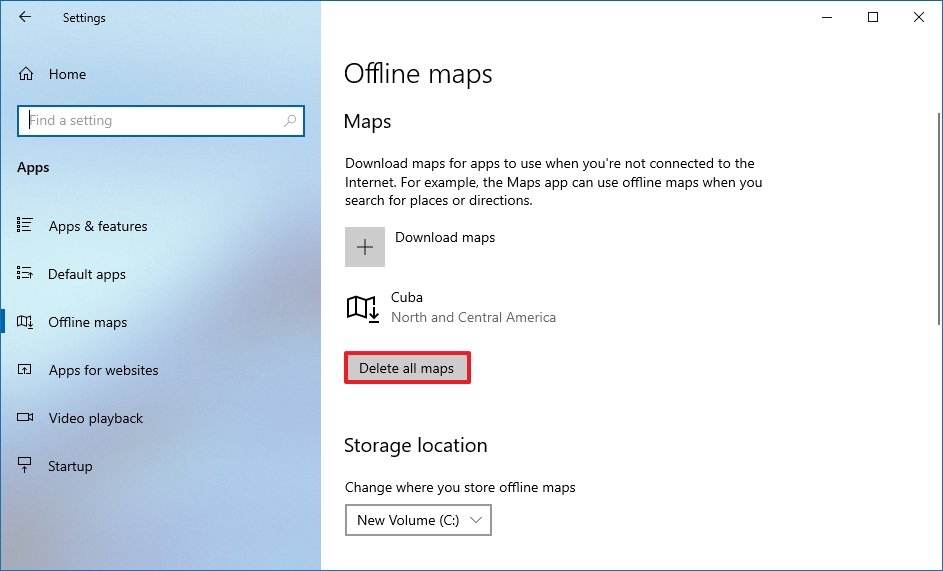 Source: Windows Central
Source: Windows Central - Click the Delete all button.
One time you complete the steps, the offline maps will be removed to make more infinite available.
Uninstall optional features
Optional features (such as Windows Media Player, Windows Howdy Face, Math Recognizer, Windows Fax and Scan, and others) likewise have up storage, and you can remove them to regain some extra space.
To remove optional features, use these steps:
- Open Settings.
- Click on Apps.
- Click on Apps & features.
-
Under the "Apps & features" section, click the Optional features option.
 Source: Windows Central
Source: Windows Central - Click the "Sort past" bill of fare and select the Install Size option to determine the feature using the most infinite.
- Select the feature to remove.
-
Click the Uninstall button.
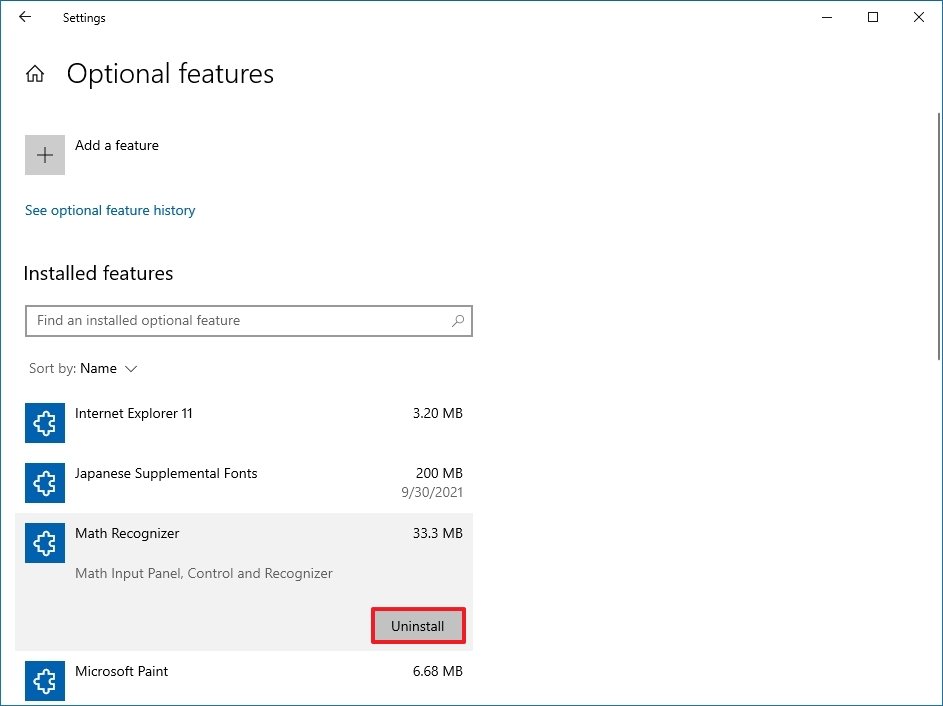 Source: Windows Central
Source: Windows Central
Afterward y'all complete the steps, you lot may need to repeat the instructions to remove other features you may no longer demand.
6. Gratuitous upwards space transferring files to external drive
If the computer still does not have plenty space, you tin can add an external drive to motion files over the new location. You tin can fifty-fifty configure the organisation to make the external storage the default location to save files.
Transfer local files to external bulldoze
To transfer existing files to an external storage, connect the drive you volition dedicate to the figurer, and then use these steps:
- Open File Explorer.
- Scan to the folder with the content taking the virtually space.
- Select the items to move.
-
Click the Motility to button from the "Habitation" tab.
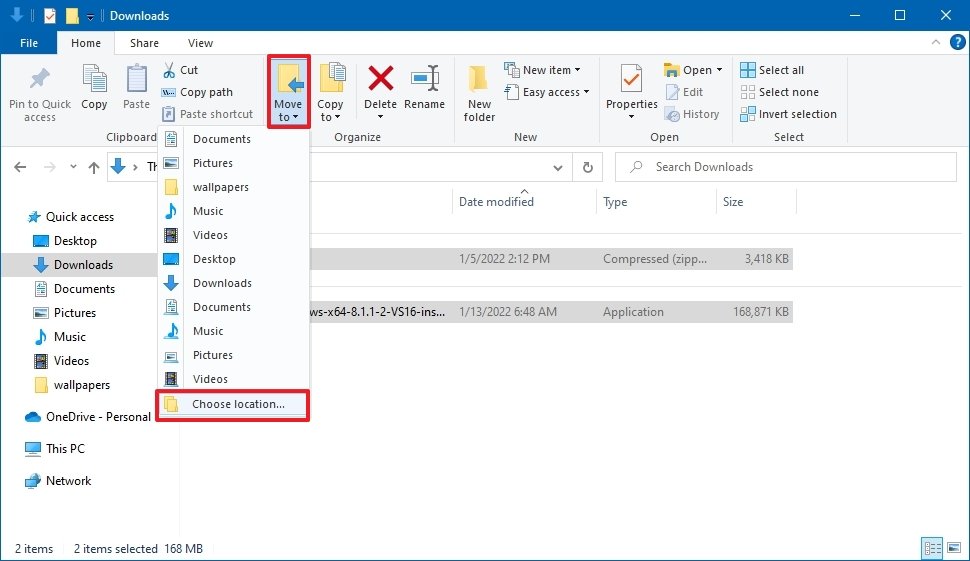 Source: Windows Key
Source: Windows Key - Select the Choose location option.
-
Select the external storage as the new destination.
Quick tip: If you want to proceed files organized, you lot can utilize the available pick to create a new binder to store the files in the new location.
-
Click the Move button.
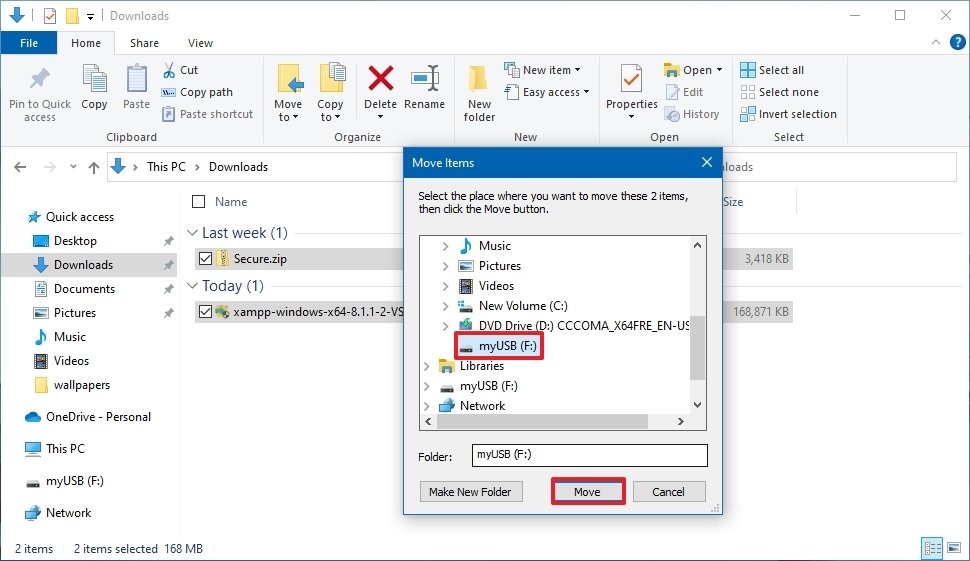 Source: Windows Cardinal
Source: Windows Cardinal
Afterward you consummate the steps, yous may need to echo the instructions to move boosted files and folders to a new location to reduce the storage usage in the drive running out of space.
Configure external bulldoze as new save location
To let the organisation to save files and install apps on an external drive automatically, apply these steps:
- Open up Settings.
- Click on System.
- Click on Storage.
-
Under the "More than storage settings" section, click the Alter where new content is saved option.
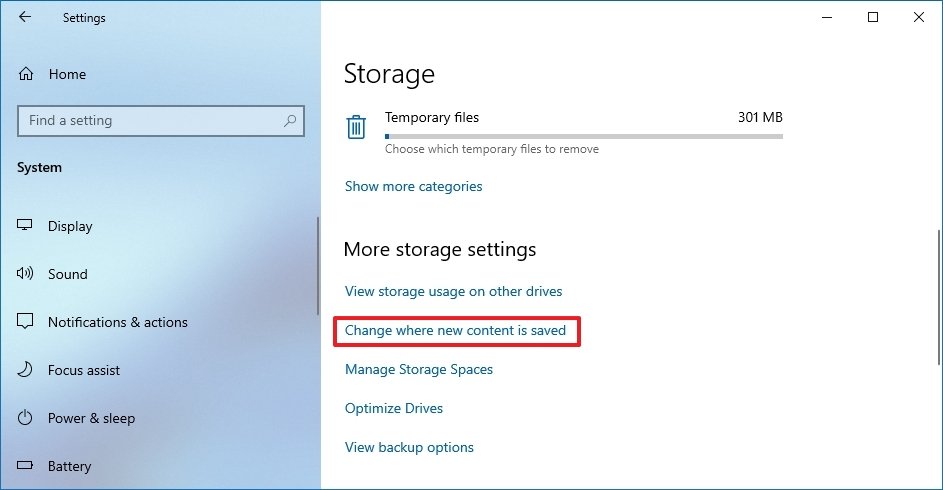 Source: Windows Central
Source: Windows Central -
Employ the drop-down menus and select the new location to save files automatically for each content type.
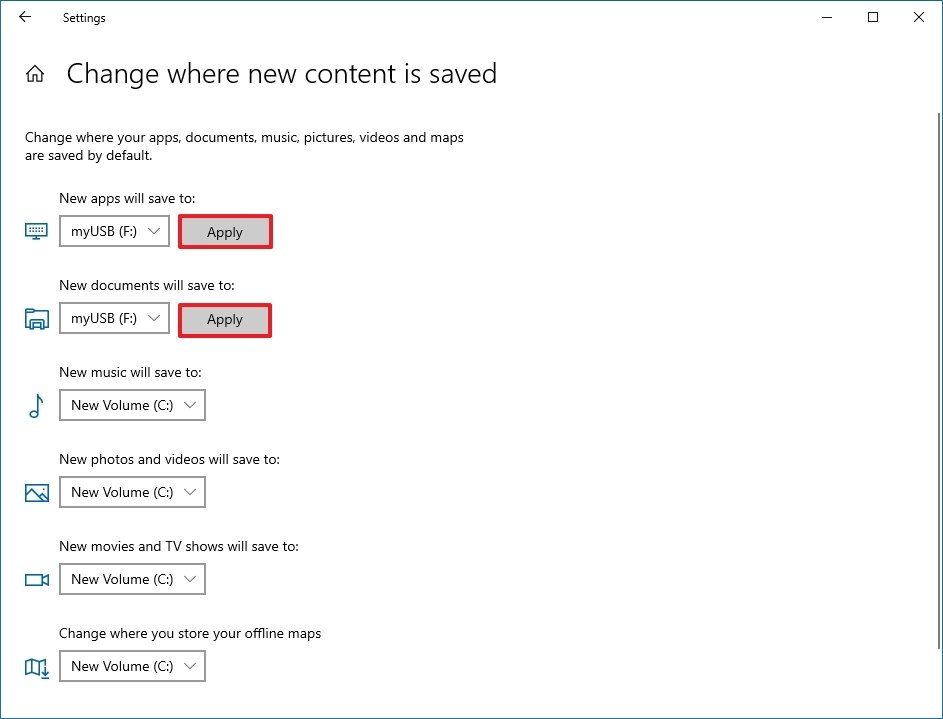 Source: Windows Cardinal
Source: Windows Cardinal - Use the "New apps will exist relieve to" drop-downwardly menu to select the drive to install hereafter apps by default.
- Click the Use button for each setting.
Once you complete the steps, files, and apps from the Microsoft Store will salvage in the new location you specified.
Relocate apps and games to new drive
On Windows 10, yous can motion nigh apps and games from the Microsoft Store already installed on the computer to an external storage, which can help reduce storage usage on the system bulldoze.
To transfer existing apps and games to some other drive, connect the external storage to the computer, and then utilise these steps:
- Open Settings.
- Click on Apps.
- Click on Apps & features.
- Use the "Sort past" filter and select the Size view to rapidly place the apps and games using the most space.
- Select the item to relocate.
- Click the Move button. (If the selection is non available, the transfer characteristic is not available for that particular item.)
-
Use the drop-downwardly menu to select the new location.
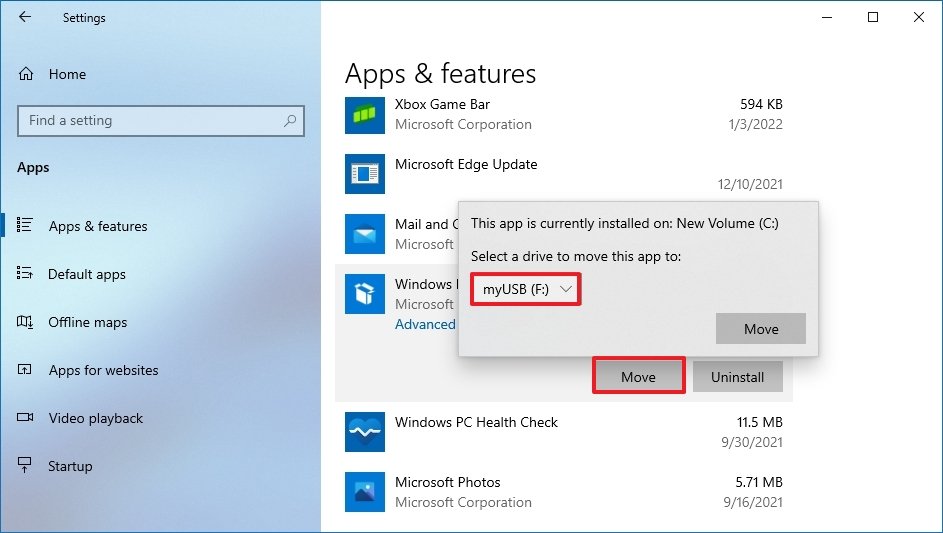 Source: Windows Central
Source: Windows Central - Click the Motion push button once more.
Afterward you lot complete the steps, yous may demand to repeat the same instructions to motion boosted apps or games to the new location.
When using this feature, the external drive must always exist connected to the device. Otherwise, y'all won't be able to launch the apps or play those games you moved to the new storage.
7. Free up infinite using NTFS pinch
You can besides use the compression feature part of the NT File System (NTFS) to reduce the storage usage of current files maintaining normal admission without the need to zero your files. The feature is available to compress files, folders, or the entire drive.
Important: Data compression tin negatively touch on system performance as information technology has to shrink and decompress information on the wing. You lot should utilize this option only if you do not have some other option or accept capable hardware.
Enable folder pinch
To enable Windows ten NTFS compression for a folder, utilise these steps:
- Open File Explorer.
- Browse to the binder to compress.
- Correct-click the folder and select the Backdrop choice.
-
Click the Advanced button.
 Source: Windows Cardinal
Source: Windows Cardinal - Under the "Compress or Encrypt attributes" department, bank check the Compress contents to relieve deejay space option.
-
Click the OK button.
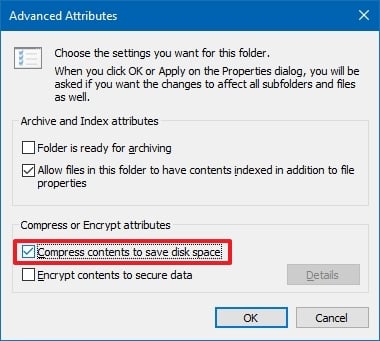 Source: Windows Central
Source: Windows Central - Click the Use button.
-
Select the Apply changes to this folder, subfolders and files option.
Quick note: If the folder already contains files, the initial compression can take time.
- Click the OK button.
- Click the OK push once more.
Subsequently you complete the steps, the file compression characteristic volition enable reducing the size of existing and time to come files. (The above steps focus on folders, only the same instructions use to shrink files individually.)
If you no longer want to use file compression, yous tin can revert the changes using the same instructions, but on step 5, make sure to articulate the Compress contents to save disk infinite option.
Enable drive compression
To enable NTFS compression for the unabridged bulldoze, utilize these steps:
- Open File Explorer.
- Click on This PC from the left pane.
- Under the "Devices and drives" section, right-click the drive to compress and select the Properties option.
-
Bank check the Compress this drive to save deejay space option.
 Source: Windows Primal
Source: Windows Primal Quick tip: Since compressing the installation drive tin can negatively bear upon performance, try using this feature simply on a secondary drive or sectionalisation.
- Click the Apply push button.
- Select the Apply changes to drive (bulldoze letter of the alphabet), subfolders, and files option.
- Click the OK push.
- Click the OK push again.
Once y'all complete the steps, the file system will compress the drive and any content already on the storage without reformatting.
When the feature is no longer needed, you tin can employ the same instructions to disable compression, merely on stride 4, make sure to clear the Shrink this drive to save disk space option.
8. Gratuitous up space disabling Hibernation on Windows 10
Hibernation is a nifty characteristic available on Windows 10, which saves the information in memory onto the organization drive before shutting downward to preserve the electric current session upon resume. When the device comes dorsum online, you can pick up where you left off.
Although it is a convenient feature, it requires gigabytes of space to relieve the memory information into the hiberfil.sys file. If the device is running out of room, disabling Hibernation tin assistance free upwards infinite for more disquisitional files.
To disable Hibernation on Windows 10 to free upwards space, use these steps:
- Open Showtime.
- Search for Command Prompt, right-click the acme result, and select the Run equally administrator selection.
-
Blazon the following control to disable Hibernation on Windows x and press Enter:
powercfg /hide off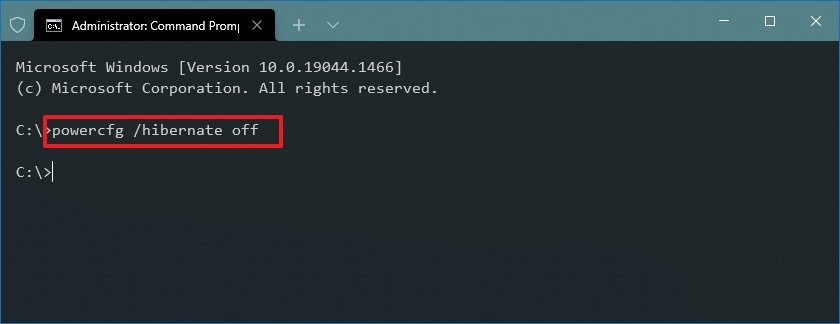 Source: Windows Fundamental
Source: Windows Fundamental
Once you complete the steps, Hibernation will no longer be available, merely you lot will have more space for other files.
In the futurity, you can always re-enable the feature with the same instructions, but on step 3, make sure to apply the powercfg /hibernate on command.
9. Gratuitous up space compressing installation footprint of Windows 10
Compact Bone is a tool that compresses the footprint of Windows 10 and apps. The characteristic is meant for devices with limited storage, but you tin can use the tool to speedily reclaim a few gigabytes of space when you do not have external storage.
Alarm: This is a friendly reminder that modifying system files is risky, and it tin can cause irreversible damage to your installation if you do not do it correctly. Earlier proceeding, it is recommended to make a temporary full fill-in of your PC.
To shrink the size of the Windows 10 installation and apps, apply these steps:
- Open Start.
- Search for Command Prompt, correct-click the top result, and select the Run every bit administrator selection.
-
Type the following command to enable Compress OS and printing Enter:
compact.exe /compactOS:ever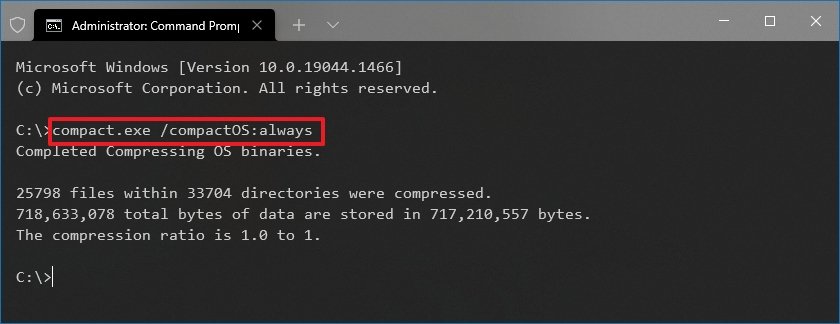 Source: Windows Fundamental
Source: Windows Fundamental
After you complete the steps, the procedure will reclaim around 2GB of storage, slightly affecting performance.
When the characteristic is no longer needed, you can always revert the changes using the same instructions, but on footstep 3, make sure to use the meaty.exe /compactOS:never command.
10. Free up infinite rebuilding search indexer on Windows 10
The Windows Search database tin sometimes grow very large for the corporeality of content that needs indexing or indexing problems, and it can be one of the cases the organisation drive is running out of space. If this is the case, clearing and rebuilding the database and modifying the index items can significantly reduce storage usage.
To rebuild the index of Windows x, apply these steps:
- Open up Settings.
- Click on Search.
- Click on Searching Windows.
-
Under the "More Search Indexer Settings" department, click the Advanced Search Indexer Settings option.
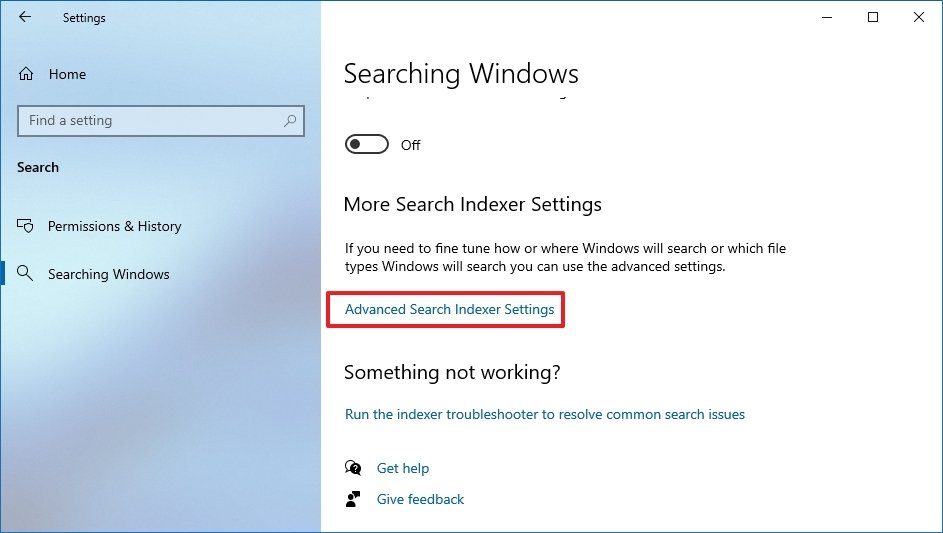 Source: Windows Primal
Source: Windows Primal - Click the Advanced button.
- Click the Index Settings tab.
-
Under the "Troubleshooting" section, click the Rebuild button.
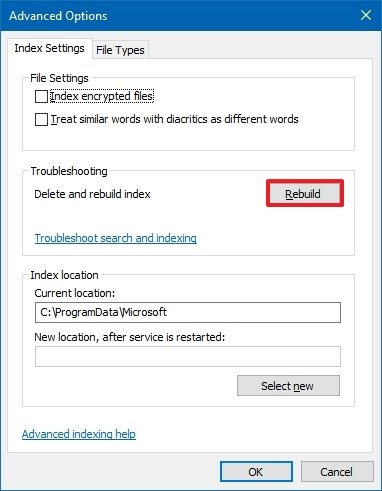 Source: Windows Central
Source: Windows Central - Click the OK push.
Once you complete the steps, the system volition clear and rebuild the Windows Search feature'due south index database.
The only caveat with this process is that during the rebuild, searches using the Taskbar, File Explorer, and beyond the experience might exist incomplete until files are re-indexed.
Configure indexer
You can too minimize the space by preventing Windows Search from indexing specific locations.
To remove indexing folder locations from Windows Search, employ these steps:
- Open Settings.
- Click on Search.
- Click on Searching Windows.
-
Under the "More Search Indexer Settings" section, click the Advanced Search Indexer Settings option.
 Source: Windows Key
Source: Windows Key - Click the Alter button.
- Click the Testify all locations push.
-
Clear the options for apps to exclude from the alphabetize database.
Quick notation: Generally speaking, yous never desire to alphabetize whatever kind of application.
-
Expand the C: drive and articulate the folder you do not wish to announced in search to reduce the database storage usage.
 Source: Windows Central
Source: Windows Central - Click the OK push.
- Click the Close button.
After you complete the steps, Windows Search volition update the database, hopefully reducing its footprint, and making space for other files.
xi. Gratis up infinite deleting users no longer sharing device
If y'all share a computer with other people, it may be possible to costless up space past deleting accounts that no one is using anymore.
To delete user accounts and data on Windows 10, use these steps:
- Open up Settings.
- Click on Accounts.
- Click on Family & other users.
- Select the account no longer in utilise.
-
Click the Remove button.
 Source: Windows Central
Source: Windows Central -
Click the Delete business relationship and data push.
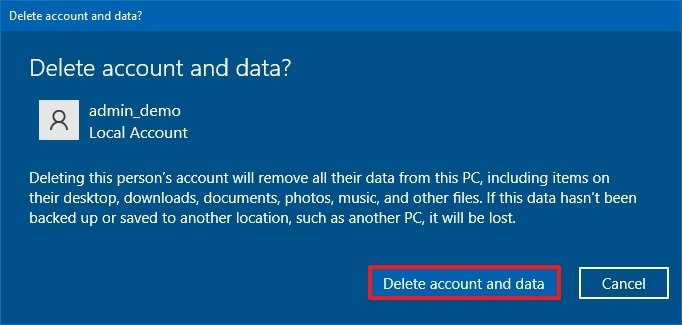 Source: Windows Primal
Source: Windows Primal
Once yous complete the steps, the profile and information volition be removed from the estimator, regaining more space for other files. Y'all may need to repeat the steps to delete other accounts.
12. Free up infinite disabling Reserved Storage on Windows 10
Windows 10 also includes "Reserved Storage," a feature that sets autonomously several gigabytes of space for updates, organization cache, and temporary files. When new updates are available, the organisation will automatically clean up the storage to minimize bug during other updates.
Although this is a useful feature to minimize problems during updates and upgrades, it takes abroad infinite you could use to store more documents, pictures, and videos. If you understand the characteristic and prefer not to apply it, you tin disable information technology to free up additional space. The just caveat with this method is that once you disable the feature, the changes will apply during the next feature update of Windows.
Important: Merely utilize these instructions if you understand the characteristic. Otherwise, it is not recommended to disable Reserved Storage because the chances of problems during an update will be higher.
To disable Reserved Storage on Windows 10, use these steps:
- Open Start.
- Search for PowerShell, right-click the elevation result, and select the Run as ambassador option.
-
Blazon the post-obit control to ostend whether the characteristic is enabled and press Enter:
Get-WindowsReservedStorageState -
Type the post-obit command to disable the characteristic and printing Enter:
Set-WindowsReservedStorageState -Country disabled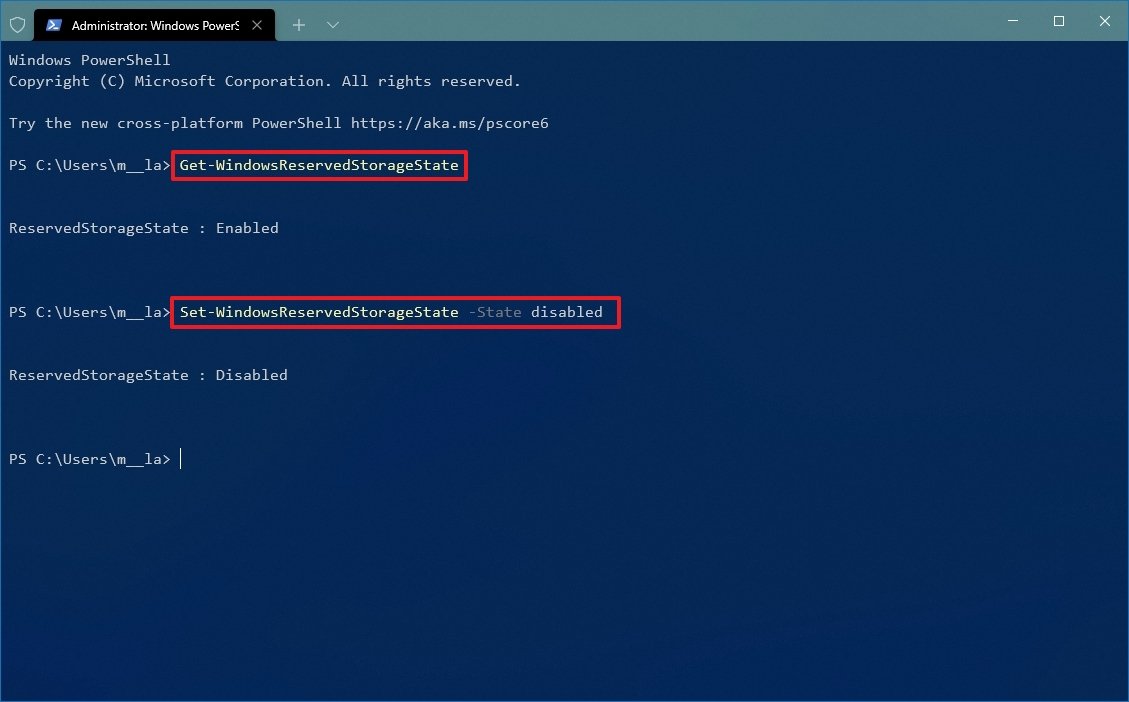 Source: Windows Key
Source: Windows Key
After you lot complete the steps, Reserved Storage will disable on Windows 10, allowing y'all to reclaim around 7GB of space after the next characteristic update of Windows 10.
In add-on to all these dissimilar ways to free up bulldoze space, sometimes malware can cause storage problems. If you lot notice foreign behaviors and the hard drive is running low in space, a virus may be causing the problem. If this is the example, yous can apply these instructions to browse, discover, and remove any malware causing storage issues.
More Windows resource
For more helpful articles, coverage, and answers to mutual questions near Windows x and Windows 11, visit the following resources:
- Windows xi on Windows Central — All you need to know
- Windows 11 help, tips, and tricks
- Windows 10 on Windows Key — All you demand to know
We may earn a commission for purchases using our links. Larn more.
Source: https://www.windowscentral.com/best-ways-to-free-hard-drive-space-windows-10
Posted by: redmondthentent.blogspot.com







































0 Response to "12 best ways to free up hard drive space on Windows 10"
Post a Comment